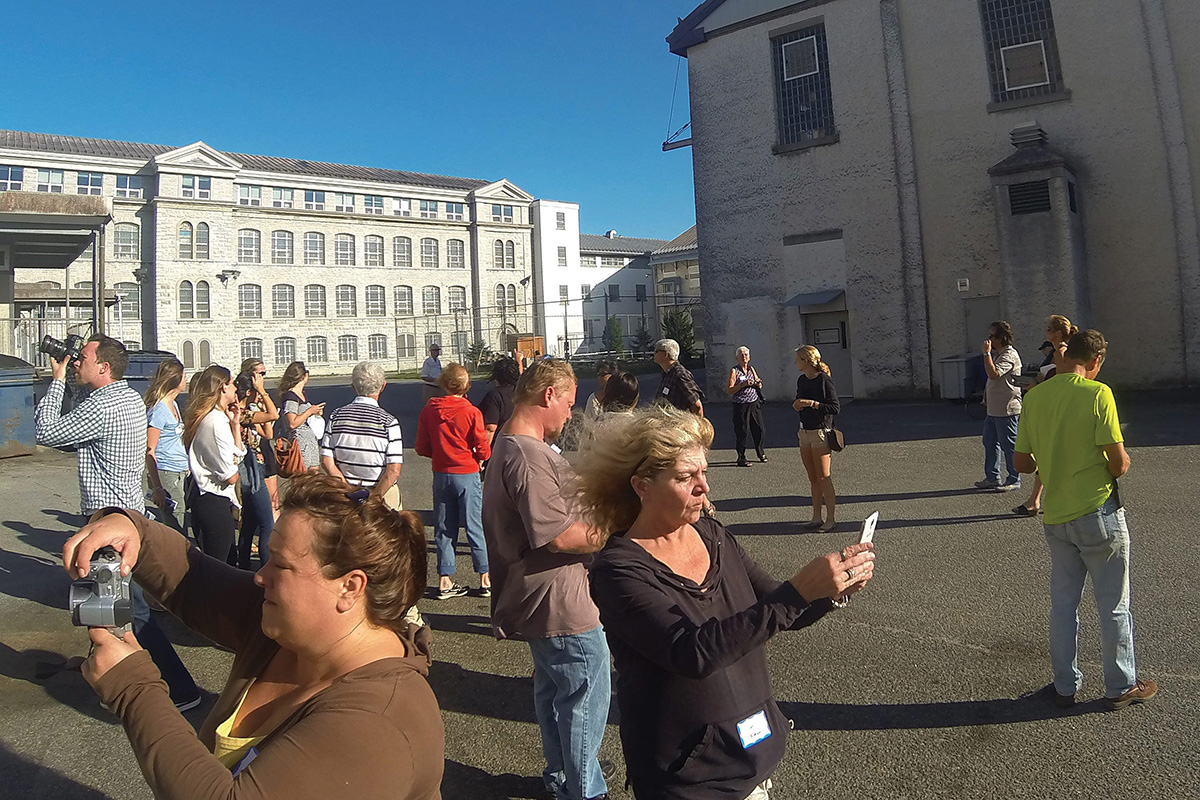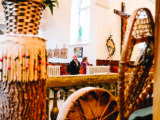The Kingston Penitentiary was home to Canada’s toughest criminals for 178 years before the federal government shuttered the maximum-security institution three years ago. Now, the decommissioned prison offers tours to the public. A look behind its imposing limestone walls offers insight into how the men who did time here were more than just the sum of their crimes — they were also sons, husbands and fathers.
You can see this in the drawings of Mickey and Minnie Mouse made by inmates on a wall in the open visitation room, in a corner designated as a children’s play area. And in the row of semi-detached cottages with tiny yards where, for 72 hours every two months, model prisoners could pretend they were living a regular life, barbecuing behind coils of barbed wire, watching TV with their kids, having dinner with their mother or sharing intimacy with their spouse.
You may unsubscribe from any of our newsletters at any time.
But these glimpses of humanity are overshadowed by the sensationalism of the place: its reputation for retribution rather than rehabilitation, as indicated by its long history of employing instruments of torture such as a strapping table, used until 1968, where a prisoner’s wrists and ankles were shackled while he was beaten with a leather belt by guards who received extra pay for their vicious work; the brutal riot of 1971 when inmates took control of the prison for four days; the not-uncommon suicides and suicide attempts; the tense and threatening environment that made it necessary for inmates to carry homemade shivs and shanks.
But mostly, Kingston Penitentiary (“KP,” as it’s known) is notorious for being linked with this country’s most reviled inmates, the dozen or so headline-grabbing names among the 400 prisoners who lived there in the last years of the prison’s operation. The infamous men of the Lower H-range, locked up 23 hours a day in protective custody behind a shield of Plexiglas over the steel bars of their cells to prevent other prisoners from hurling objects at them and to stop them from throwing their own human waste at their jailers, included Russell Williams, Paul Bernardo, Clifford Olson, Wayne Boden, Michael Rafferty and Mohammad Shafia.
Known as Canada’s Alcatraz, it’s no exaggeration to call KP a hellhole. It’s a place where no one ever wanted to end up. But now tens of thousands of tourists want in.
They are so eager to get behind these bars that 300,000 users logged on to the tour website to scoop up 40,000 tickets on the first day of sales when a limited 14-week run of tours was offered earlier this year. (An additional 28,000 went just as fast.) Scalpers have sold them for quadruple their value. The last time a tour was offered at KP, for a 15-day run in 2014, all 18,000 tickets were sold in an hour. The tours pumped $6 million of tourism money into the local economy this year, and their staggering popularity is fuelling speculation that the storied structure, located on the shores of Lake Ontario in one of the most desirable areas of the city, will soon become a year-round attraction as part of the city’s waterfront redevelopment plan, set to be announced in the spring.
Darren Dalgleish couldn’t be happier about all this. The general manager and CEO of the St. Lawrence Parks Commission, the provincial tourism agency tasked by Correctional Service Canada (CSC) and the City of Kingston to run the tours, says turning KP into a permanent tourist destination represents “the greatest opportunity for tourism asset development in Ontario and Canada.”
Prison life “is huge in pop culture right now,” he says, noting the popularity of prison shows such as the hit Netflix series Orange is the New Black. Prison museums are popular the world over. Alcatraz, the San Francisco prison that closed in 1963, attracts more than 1.3 million tourists who spend over $46 million on tickets each year. Other prison museums include Philadelphia’s Eastern State Penitentiary, Australia’s Old Melbourne Gaol, England’s The Clink and South Africa’s Robben Island, where Nelson Mandela, anti-apartheid revolutionary and former South African president, was imprisoned for 18 years. They are part of the growing sector known as “dark tourism”: travel destinations associated with human suffering, including battlefields, concentration camps and tragic sites such as Ground Zero, the Chernobyl Zone and the Cambodian killing fields.
Despite their immense popularity, the KP tours are not without controversy. Some prisoners’ rights advocates say they profit from human suffering. They argue the tours dehumanize prisoners while elevating the status of their captors and sensationalizing infamous inmates.
They say the tours miss an opportunity to educate visitors about the anguish of prison life and the root causes of criminal behaviour, as well as the reasons for the disproportionate number of Indigenous and black Canadians in jail. They also take issue with the KP’s gift shop, which they say trivializes the harsh reality of prison life by selling merchandise such as stainless steel prison food trays and mugs.
“A lot of people and organizations are criticizing me for leading this — I hope the United Church isn’t going to be one of them,” says Dalgleish. “Some people are comparing what we’re doing to showing off a suffering dog in a kennel and asking, ‘How can you make money off the backs of victims?’” He disagrees with these criticisms and says it’s unreasonable to expect the tours to address all the complex cultural factors that result in incarceration. He says the KP guides are actually instructed not to share details about high-profile prisoners for privacy reasons and out of respect for victims’ families (though the tours do linger in the segregated H-range). “It’s not our intent to educate everyone. It’s not incumbent upon me as a tourist executive to decide what all the public interests are,” he says. “The ultimate goal is to drive tourism to Kingston.”
His most vocal opponents are two Canadian criminology professors, Justin Piché at the University of Ottawa and Kevin Walby at University of Winnipeg, who have published several academic papers critical of prison tourism. In June 2016, the duo penned an opinion piece in the Toronto Star criticizing the KP tours for their focus on “exceptional prisoners or prison incidents [such as prison riots and escapes] with less emphasis placed on the stark realities of the deprivation of liberty. Also glossed over is exactly what has led some to be incarcerated, including the social, economic, legal and political processes that criminalize some people, but not others.”
Most visitors don’t appear to have such ethical qualms. “There is a huge interest in getting into the prison; it’s about opening up the mystery,” says Donna Morrin, a former KP warden and one of 29 former KP staff members leading the tours. “People want to hear about the great stories, the stuff that made a splash in the media, the blood and guts and gore, the riots. . . . And they have all kinds of questions about the high-profile offenders — they want to know: ‘Have you ever spoken to them? What do they look like? What do they do? Are they crazy?’ They are interested in the dark side.” In keeping with the privacy policy, Morrin declines to answer these questions.
Rev. Wayne Soble, a minister at Kingston’s Edith Rankin Memorial United, who has visited the jail as a chaplain and whose church offers an accompaniment program for offenders, is bothered that so many are driven to the place by morbid fascination. “Some go away disappointed because they didn’t get to walk into Paul Bernardo’s cell.” For Soble, tourism that capitalizes on both human evil and on the system’s failure to redeem broken lives is offensive. “KP was a dreadful place. There are stories of pain written on the walls.” Still, he understands people’s desire to go there. In fact, he tried — and failed — to secure a ticket for himself last summer.
Certainly, the 90-minute tours provide a fascinating and formerly forbidden glimpse into the fortress. They cover the physical grounds (the visitation room, conjugal cabins, the suffocatingly small windowless cells, the igloo-style fortress in the centre of the prison with its ready arsenal of weapons in case of unrest), its long history of prisoner mistreatment and famous incidents.
But there’s a lot that no one talks about on the tours — the mental anguish of prisoners in long-term solitary confinement, cutbacks to rehabilitative programs, prisoner-on-prisoner violence, high rates of suicide and, most notably, abuse and corruption by guards.

One of the best things about the tours is the fact that they boost the self-esteem of former employees who worked there, says Sheila Menard, a former parole officer and case-management supervisor and also a member of Kingston’s Chalmers United, who assists on the tours. “There were corrections officers who, when they left their careers, often didn’t feel proud of their work. They were hated by inmates. They would come away at the end of their workday feeling like they hadn’t done anything worthwhile. All of a sudden, now they are being validated and feel a sense of pride.”
Jason Godin, who heads the national union of correctional officers, also praises the tours for their positive impact on former staff. “We did the job nobody wanted to do,” he says, noting that a federal report indicates 36 percent of correctional officers in federal jails have been affected by post-traumatic stress disorder because of having to deal with inmate gangs, suicides, medical emergencies, makeshift weapons and prisoner attacks.
But critics say tours led by former staff with “sanitized” scripts approved by CSC are one-sided. “You get their take on things. You know, narratives of sacrifice, of doing the necessary public safety bit for Canadians,” Piché told CBC Radio. “You rarely get to hear from the perspective of prisoners of what it was like to be confined there.” Ex-inmates would no doubt offer a vastly different perspective than the CSC regarding certain incidents. For example, in the 1971 prison riot at Kingston Pen, prisoners took six guards hostage in an effort to secure better prison conditions. Their actions, though no doubt terrifying for guards and their families, ultimately led to an inquiry that made recommendations for avenues for prisoner redress. “If these tours are going to continue we need to include the prisoners’ voices,” says Soble.
Some jail museums, including Alcatraz and Eastern State, have included prisoner narratives on their tours. At Robben Island, former prisoners serve as tour leaders.
Dalgleish doesn’t rule out the possibility of this happening at KP in the future (in fact, he calls it a “brilliant” idea). But he stresses that ex-inmate tour guides would have to stick to an official script. “If they said the guards were a—holes or something like that, they would be breaking the employment contract.” Similarly, Morrin, the former warden, says she has no problem with ex-inmates as guides as long as they don’t “slam management.”
Dalgleish argues the tours can serve as a catalyst for law-and-order types to become more compassionate to the plight of prisoners. He himself “went in with one view and came out with another — there’s no question I’m enlightened,” he says. “I used to be of the opinion: ‘So what if prisoners don’t get their exercise breaks?’ But now I look at it with a more humane perspective. They weren’t all bad people.” One of the things that touched him most was seeing a calendar in a cell where a prisoner had marked the upcoming date of his son’s birthday. “I have a son, too,” he says.
His tour guides have a similarly compassionate perspective, he insists. “We have tour leaders who are former KP educators, nurses and psychologists and every one of those people sees the possibility for redemption in these human beings, and that’s the story they tell.” In fact, he says, some visitors have complained the tours are too soft on inmates. “Some people think we are too kind about the prisoners who were there. When they hear, for example, a former nurse talking about helping murderers and pedophiles and she is being empathic, that’s confusing to some.”
Some victims have been profoundly impacted by the tours. Menard recounts the story of a grown man who had been molested as a child by a pedophile who later died in the prison. The man’s wife hugged the tour guide in gratitude because it offered her husband a measure of comfort. On another tour, Dalgleish met the mother of a victim of one of the high-profile inmates. “I was taken aback by the fact that she had tremendous empathy for the inmate even though he killed her daughter.” There have been other surprising visits, such as a former inmate who spent 28 years on the inside. “He was crying and so emotional about being able to walk freely through all these areas,” says Dalgleish.
He is confident the tours will continue their popularity if KP is allowed to open as a permanent museum. “We all want to know what life was like for the guards and the workers and the inmates. We want to know if The Shawshank Redemption is real.”
Piché and Walby, the two criminology professors, hope future planning for the KP tours will include exhibits addressing the causes of incarceration with input from academics and prisoner solidarity groups. “The responsibility of curators is public education,” says Walby.
Adds Piché: “Cultural museums are supposed to open our minds to the broader context.”
No doubt they’ll be disappointed if Dalgleish’s ambitious marketing plans for the place are realized. He envisions expanding the site to potentially include accommodations that would offer “escape package” and “honeymoon in solitary confinement” weekend specials where people would be fingerprinted at the start of their weekend and be “paroled” at the end. “I’m just a tourism guy,” he says. “All I know is we have customers waiting.”
Not surprisingly, Piché is outraged by such marketing schemes. “At a time when [solitary confinement] has come under great scrutiny, notably in Canada with the deaths of Ashley Smith, Eddie Snowshoe and others, at a time when mass incarcerated Indigenous peoples have fewer chances of getting parole than their non-Indigenous counterparts as we allegedly work towards reconciliation, I would have thought ‘honeymoons in solitary confinement’ and being ‘paroled’ after a vacation would be unimaginable propositions,” he writes in a mid-October email just as nationwide headlines emerged about Adam Capay’s 1,560 days in isolation in a Thunder Bay, Ont., jail. “In what other context would making money by further degrading and dehumanizing those who have suffered in a state institution be accepted as an appropriate way to make a dollar?”
Whatever approach KP takes in its tourism efforts, there’s no denying there will be a long lineup of people eager to get in, just as there was in the 1800s when the jail offered tours so the public could gawk at prisoners in their dank cells furnished with straw beds and buckets for toilets. Back then, the tour was just 25 cents. Now it’s $25 — proving that while some things change, other things have stayed the same.














